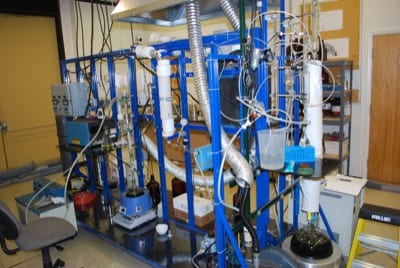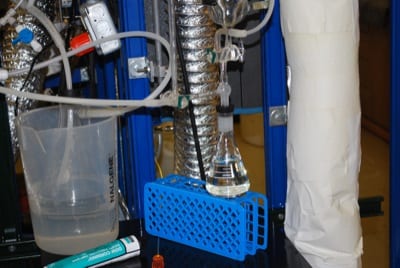Swift Fuels has been working on a 100 octane unleaded avgas for a number of years. I have been, shall we say, less than enthusiastic about the company’s work for various reasons.
However, as of late, the company seems to be making some real progress, so I drove down to Indiana to visit its facility. I am happy to report that although Swift is not “out of the woods” yet, it is making some significant progress.
The first reports from Swift were that it had a product that would meet all of the requirements of general aviation, which could be produced for significantly less than the then current price of 100LL. Whenever I see something that sounds too good to be true, it usually is.
Also, company officials seemed to have a sure answer to every question, which is usually a sure sign that they did not understand the complexity of the problem.
Swift officials also made one of the biggest mistakes any new aviation company can make: They stated that they had flown the new fuel in an airplane, implying that it should be ready for approval for everything.
Finally, they had never really produced any of the fuel, but just bought the components to demonstrate how great it will be.
The first thing I learned on my visit was that the company’s officials now understand the complexity of cost estimates, so they no longer make any firm cost projections. They hope that the cost will be in the “ballpark” of current 100LL, but much will depend on who they can get to produce the fuel and what feedstocks will be available to them. For example, if Swift partners with a company with excess syn-gas and/or underutilized production facilities, the cost will be lowered significantly.
 The process Swift will use is to produce acetone from any of a variety of feed stocks. It then runs the acetone through a catalytic reactor and distillation process to produce mesitylene for blending into the finished fuel.
The process Swift will use is to produce acetone from any of a variety of feed stocks. It then runs the acetone through a catalytic reactor and distillation process to produce mesitylene for blending into the finished fuel.
There is an old saying that if you can keep your head about you when those around you are losing theirs, it is evident that you do not understood the gravity of the situation. Well, I feel the Swift officials are now starting to understand the complexity of the situation.
 The biggest change is that they are actually using good science to test and evaluate the fuel. They have done tests in Lycoming and Continental engines, as well as a P&W R-2800 engine. They are also conducting seal and fuel system component compatibility tests, plus fuel distribution system evaluations using approved test methods. This is a huge improvement.
The biggest change is that they are actually using good science to test and evaluate the fuel. They have done tests in Lycoming and Continental engines, as well as a P&W R-2800 engine. They are also conducting seal and fuel system component compatibility tests, plus fuel distribution system evaluations using approved test methods. This is a huge improvement.
Whenever a company approaches the approval community with what I call anecdotal data, the data and test results are almost immediately regarded as insignificant. It is absolutely critical that the data presented be from tests that follow established tests methods.
This is one of the reasons that some people have a problem with the FAA. When presenting data to the FAA or other approval agencies, the tests must follow an approved procedure and one must demonstrate that the results are statistically significant. This may seem like a lot of extra work, but it is absolutely critical.
Swift is now working through that long list of tests needed to assure the FAA, et. al., that its product will work out in the field.
 The chicken and the egg problem that Swift faces is that it needs to develop or build a production facility to produce the fuel. This will cost millions of dollars, which will need to come from investors. But the investors will not come until they have assurance that the fuel will work and is approved. You add to this the Catch 22 that the company cannot get it approved until it is producing the fuel. So how do they get around this?
The chicken and the egg problem that Swift faces is that it needs to develop or build a production facility to produce the fuel. This will cost millions of dollars, which will need to come from investors. But the investors will not come until they have assurance that the fuel will work and is approved. You add to this the Catch 22 that the company cannot get it approved until it is producing the fuel. So how do they get around this?
Swift is working with ASTM to develop a spec for this fuel. The spec, ASTM D7719, will be a two component fuel containing mesitylene and isopentane with a lean rating of at least 102. The rest of the limits for the fuel will be much like the present ASTM D910 spec for 100LL. Swift officials say they hope to get the spec approved this year or maybe next year.
Once they have a spec, the approval process will begin, which includes presenting all of the data and then discussions with the appropriate authorities as to what additional tests need to be run.
The lack of a production facility means the company must purchase the components for all of the testing. It is also working on demonstration units to prove that it can produce the fuel.
Once all of the approval tests are complete and the company has issued a research report to the FAA, it will receive an STC approval for the fuel for flight evaluations, which should lead to full approval. Once it receives full approval, it can approach investors or business partners to build the facilities necessary to produce the fuel commercially.
This whole thing sounds like an impossible task, but it is just a difficult, long drawn-out affair.
The good news is that Swift officials are approaching the problem the right way. They are doing their homework and doing the necessary testing to get approval. When they can finally hit the market, they should be ready.
Will the market introduction be completely invisible? Will pilots be able to tell the difference between Swift fuel and 100LL? They may notice a slight drop in cylinder head temperature and maybe a slight increase in exhaust temp. But will this cause any problems? Probably not. But unfortunately, that is for the lawyers to decide.
For more information: SwiftEnterprises.com
Ben Visser is an aviation fuels and lubricants expert who spent 33 years with Shell Oil. He has been a private pilot since 1985. You can contact him at [email protected].
People who read this article also read articles on airparks, airshow, airshows, avgas, aviation fuel, aviation news, aircraft owner, avionics, buy a plane, FAA, fly-in, flying, general aviation, learn to fly, pilots, Light-Sport Aircraft, LSA, and Sport Pilot.
